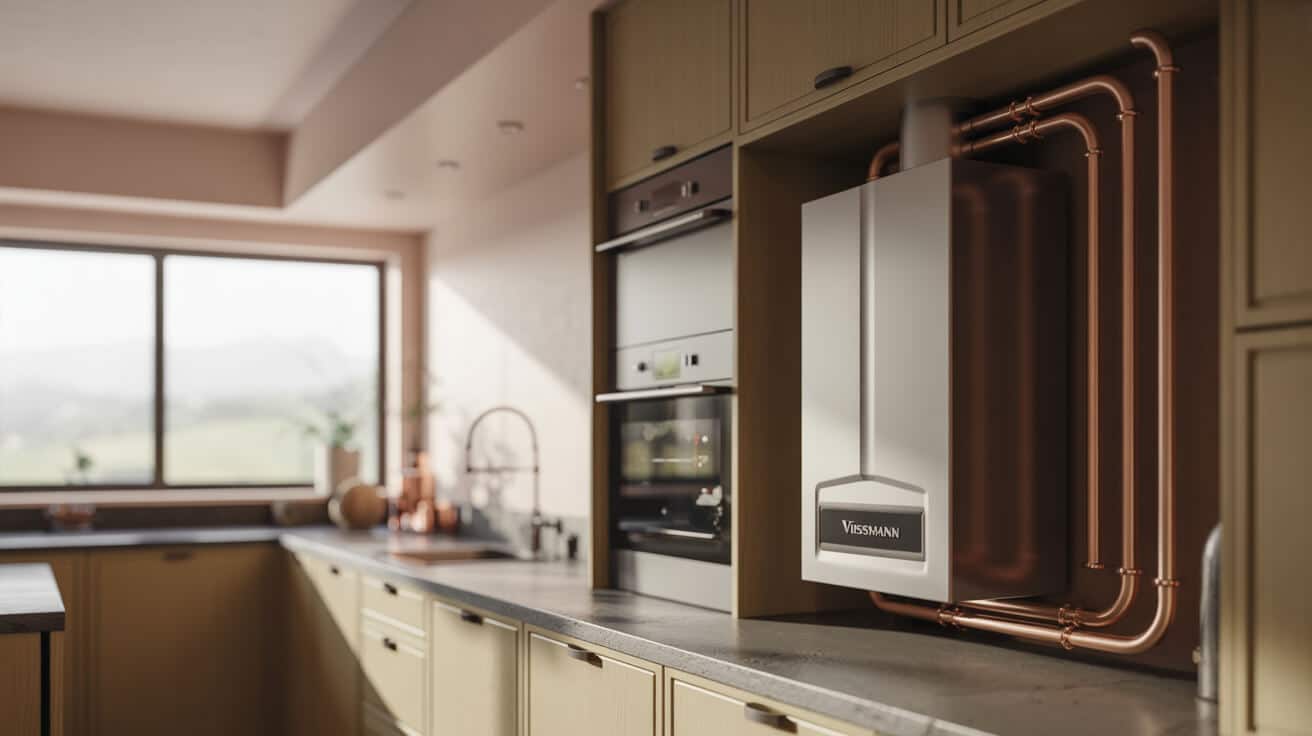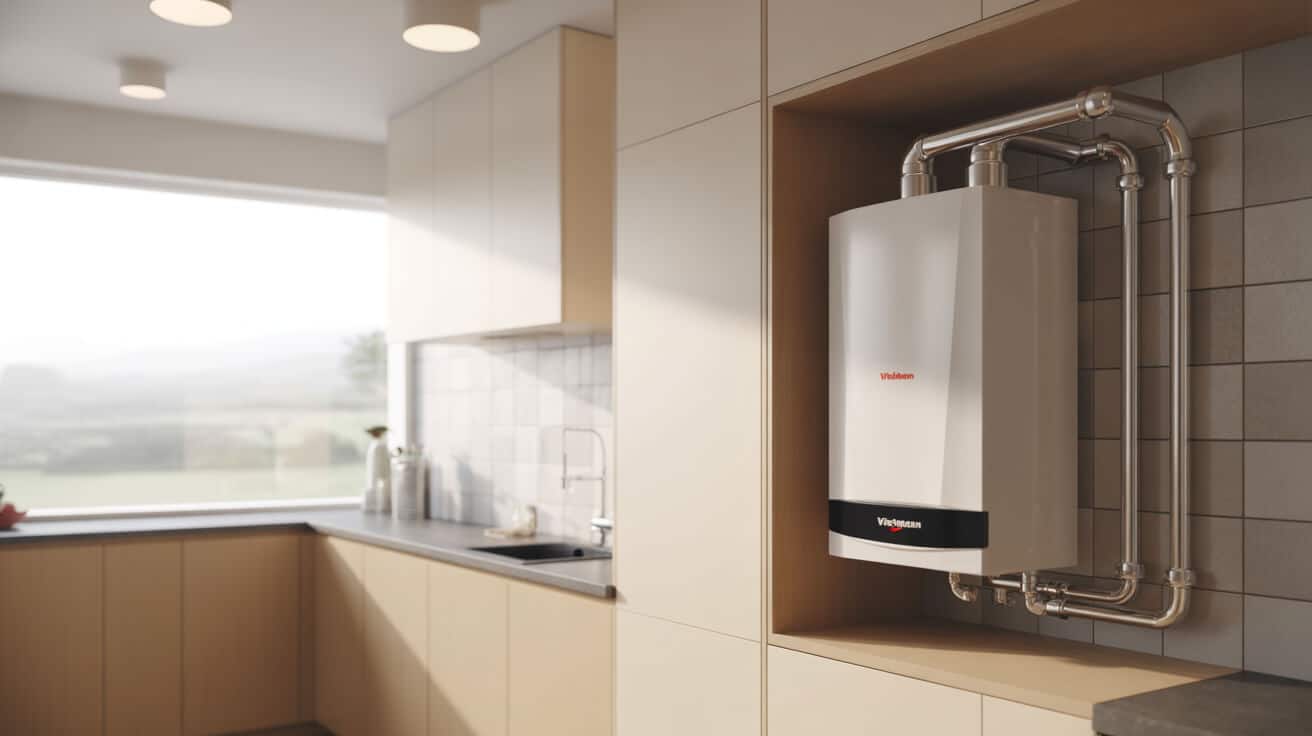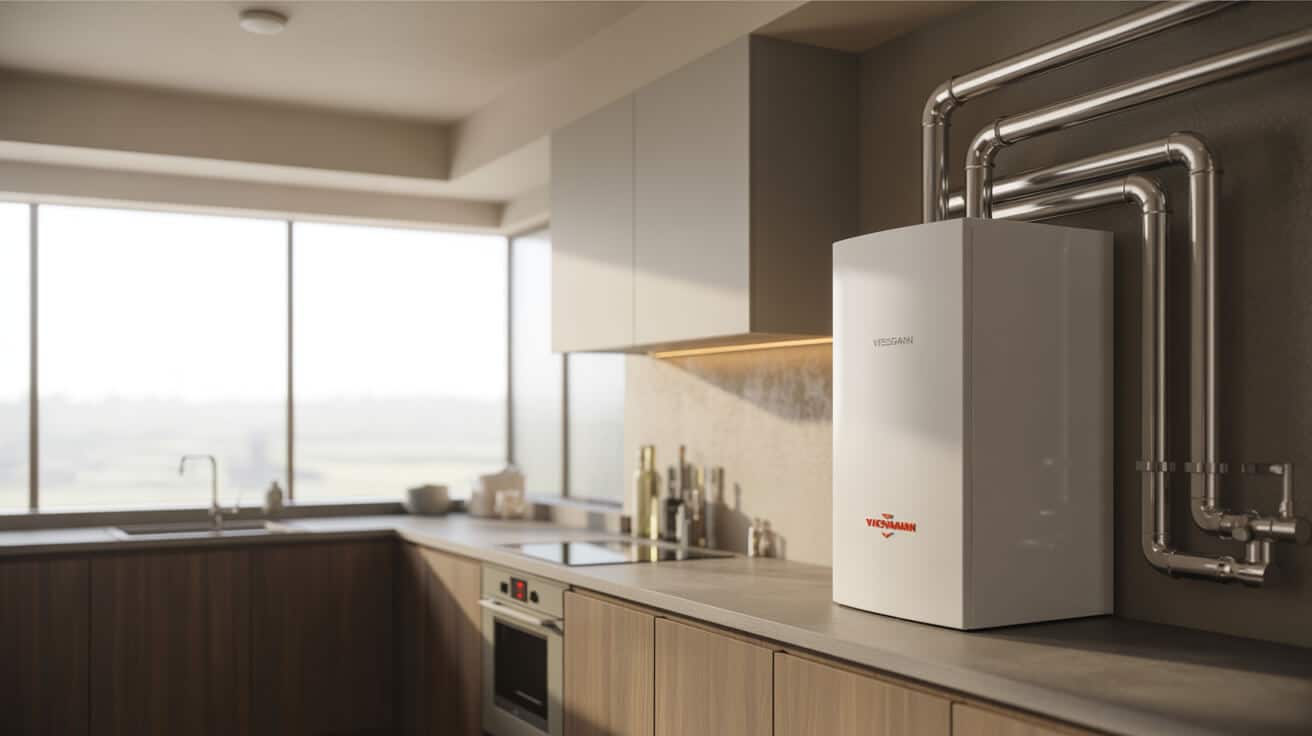Developed as a response to increasing expectations for efficient heating and robust DHW delivery in modern properties, the Vitodens 111-W provides consistent output even under peak simultaneous demand. The integrated 46-litre loading cylinder operates in concert with a high-efficiency condensing heat exchanger and advanced digital control suite. Installers such as Plumbers 4U frequently recommend the appliance for homes, apartments, and rental properties where regulatory compliance and operating efficiency must coexist with minimal installation footprint.
Etymology or name origin
Viessmann, established in Germany in 1917, incorporates “Vitodens” to signify its condensing technology—drawing from “Vito” (life) and “dens” (condensing). The 111-W identifier indicates product positioning within the brand’s storage combination range, with “W” signifying wall-mounted design. The naming strategy facilitates product stratification and clarifies interoperability for installers and property managers overseeing complex portfolios.
Overview and context
The Viessmann Vitodens 111-W functions as a wall-hung storage combi boiler, designed for BHWC (bath, hot water, heating, compliance)-intensive applications where ordinary combis fall short. Plumbing and heating companies recognise its DHW delivery as sufficient to support two showers or bath and kitchen use simultaneously, counteracting the pain points that drive callbacks and reputation risk for property owners and landlords.
Within the UK, the model addresses increasingly stringent building standards and the push towards decarbonizing residential buildings. Installers value the 111-W’s compatibility with smart controls, zoning, and rapid aftercare, all within a chassis suitable for apartments, houses, and managed units. For property management and landlord personas, this operational reliability directly reduces tenant dissatisfaction and compliance risk.
History
Product origins
Viessmann entered the UK heating market with condensing gas technology in response to European policy shifts favouring lower emissions and fuel savings. The first Vitodens models were modular and targeted at reducing fuel waste in homes. Gaps in DHW performance, particularly in simultaneous-use settings, led to the storage combi development.
Industrial emergence
The shift in legislation—ranging from the 2005 UK Building Regulations (Part L) to G3 unvented directives—accelerated demand for robust, compliant systems. The 111-W was introduced to bridge the divide: a product offering the full performance of a system cylinder in a single wall-mountable unit suitable for diverse housing stock.
Contemporary evolution
Updates to the 111-W include digital burner modulation, increased ERP efficiency, expansion of smart thermostat compatibility, and integrated error monitoring. These advances enable service providers such as Plumbers 4U to leverage cloud-based diagnostics, streamlined compliance documentation, and automated scheduling for maintenance and aftercare.

Concept and description
Appliance structure and layers
At its core, the 111-W houses a stainless steel Inox-Radial heat exchanger, high-performance gas burner, and a 46-litre loading cylinder arranged for optimal heat transfer and rapid DHW replenishment. Primary structural modules include:
- Heat exchanger: – Stainless steel, condensing, designed for longevity and corrosion resistance.
- Integrated storage: – High-recovery buffer tank for DHW, sitting directly behind the main panels.
- Pump and diverter valve: – Constant modulation, digitally controlled to alternate between heating and DHW based on demand.
- Expansion vessel and controls: – Built-in for system pressure regulation and safety.
DHW storage and flow technology
The loading cylinder employs a “charging” system, permitting top-up from the heat exchanger as soon as DHW is drawn. This ensures near-mains pressure at multiple outlets. The system’s logic prioritises DHW during peak use, temporarily pausing central heating before resuming, avoiding temperature drop at taps.
Control methods, sensors, and digital integration
A backlit digital panel forms the operational hub for user and engineer alike, presenting status, settings, and fault codes. The unit is compatible with weather-compensated controls, OpenTherm-enabled thermostats, and Viessmann’s app-based modules. Sensors throughout the system measure temperature, flow, and pressure, alerting the owner or installer to deviations for pre-emptive service.
Safety and compliance design
The Vitodens 111-W integrates a pressure relief valve, expansion vessel, G3-compliant unvented cylinder controls, and WRAS-approved water connections. Sealed combustion and sophisticated error code reporting protect against both carbon monoxide risk and dangerous system anomalies. Plumbers 4U adhere to these in both installation and compliance aftercare.
Functionality and typical applications
Operational principles
Using continuous burner modulation, the boiler efficiently transfers energy to DHW or heating loops as required. The control logic achieves stable output, even with rapid changes in demand. Should the tank’s DHW reserve reduce during use, a fast recovery sequence ensures sustained output without user intervention.
Typical use scenarios
- Detached homes: Two-person or family use includes parallel showers and dishwasher/kitchen operation.
- Flats and apartments: Centralised control in properties with multiple tenants.
- Light commercial: Small businesses, hairdressers, or clinics requiring high hot water for operational continuity.
- Rental and managed portfolios: Property managers seek fewer breakdowns, reduced tenant complaints, and a compliance-friendly maintenance cycle.
Installation considerations
Space-saving, all-in-one design allows upgrades from tanked systems in standard airing cupboards or utility rooms. Cylinder weight and wall mounting require adherence to manufacturer fixing guidelines. Plumbers 4U ensures that pre-instal walk-throughs cover water quality, flue routing, and control wiring prior to commissioning.
Installer and service notes
Annual service includes system flush, expansion vessel check, flue gas analysis, and firmware diagnostics. benchmark logbook and digital service history are maintained for compliance.
Classifications, types, and variants
Viessmann Vitodens product range
- Vitodens 050-W: For low to standard DHW needs.
- Vitodens 100-W: Enhanced modulation and compact profile.
- Vitodens 200-W: Smart, premium integration for large or tech-enabled homes.
- Vitodens 111-W: Storage combi, high DHW output, flagship for simultaneous use.
Competing storage combis
- Worcester Bosch Greenstar Highflow:
- Vaillant ecoTEC plus 938:
- Ideal Vogue Max C40 GEN2:
Capacity variants
Available as 26, 32, or 35 kW (heating output), accommodating single-bath flats to larger homes needing multi-shower operation. Smart and warranty modules add customization.
Systems, tools, and methodologies
Installation tools and workflow
- Pipe cutters, isolation valves, pressure testers: for compliant plumbing.
- Power flush pump, flue gas analyzer: for system commissioning.
- OpenTherm/ViCare modules: for advanced control and monitoring.
- Digital error code readers, firmware flash utilities: for diagnostic precision.
Service and compliance methodology
- Benchmark book completion: for warranty and compliance.
- G3 unvented certificate validation: for cylinder safety.
- Annual CP12 Gas Safety check: for tenanted and managed properties.
- Digital aftercare: including remote diagnostics and service scheduling provided by leading companies like Plumbers 4U.
Control and integration
- Weather compensation, room/zone thermostats, OpenTherm compatibility: for energy optimization.
- App-based (ViCare) and property manager dashboards: for estate-level monitoring.

Stakeholders and entities involved
Manufacturer
Viessmann Group, Germany-based, with design, production, and global supply chain.
Distributors and supply chain
UK suppliers—Wolseley, City Plumbing, Plumbase—distribute inventory, technical documentation, and critical spares.
Certified installers and service firms
Plumbers 4U and Gas Safe registered engineers leverage the 111-W’s digital tools and service portals, providing legal commissioning, routine maintenance, and aftercare.
Property managers, landlords, owners, and tenants
- Owners: Maintain warranty and aftercare history.
- Landlords: Responsible for Gas Safety, G3, and property compliance.
- Facilities directors: Integrate appliances into safety audits and scheduled servicing.
Regulatory and trade bodies
Gas Safe Register, Building Control, WRAS, and industry technical panels set and enforce compliance.
Legal, regulatory, and ethical considerations
Building Regulations (UK)
- Part L: Enforces high-efficiency standards and fuel savings.
- Part G3: Unvented cylinder safety; only certified engineers may instal.
- Part P: Mandatory certification for electrical instals.
Gas Safe registration
Legal installation is reserved for Gas Safe Registered engineers. Failure to comply voids warranty, exposes owners to regulatory action, and presents risk for non-compliance fines.
Documentation and compliance
- Benchmark book: Completed at installation; digital backup encouraged.
- CP12 certificate: Required for rental and multiple-tenant properties.
- Digital recordkeeping: Supported by firms like Plumbers 4U, simplifies audits and warranty claims.
Ethical frameworks
Installers and service providers are expected to communicate transparently, ensure safety, and minimise environmental impacts. Customer assets are safeguarded through calibrated documentation and property-tailored aftercare.
Performance metrics, data, and measurements
Efficiency data
- ERP A-class, SEDBUK up to 92% (site-dependent).
- DHW output: 18 litres/min at 35°C rise, verified on standard UK pressure.
Output and recovery
- Rapid recharge—tank returns to maximum in 5–8 minutes after draw.
- Full-size dwellings and two-bath homes experience continuous hot water with no mid-shower cold spells.
Reliability
- Manufacturer’s warranty: five years standard, up to ten with Plumbers 4U or other Viessmann-accredited installation.
- Field fault rates below 2% on major parts in proprietary audits.
Error codes and analytics
- Instant error display (F.22, F.28, D. codes) on digital panel.
- Remote engineer visibility with ViCare modules; trend analysis for proactive maintenance.
Challenges, barriers, and limitations
Technical/installation
- Wall support and space may preclude instals in micro-flats.
- Pipe and flue routing must meet manufacturer and building standards.
Digital integration
- Firmware and smart module compatibility can introduce the need for on-site updates during system upgrades.
- Legacy control systems in some properties may require adaptations.
Service and maintenance
- Hard water accelerates descaling needs; philtre and inhibitor maintenance schedules mandatory.
- Part delays possible during peak winter demand.
Legal, operational, and compliance
- Tenants’ right of access for servicing can cause scheduling delays.
- Non-qualified work voids warranty and introduces regulatory risk for property owners.
Impact, influence, and legacy
Market and compliance
- Supports improved EPC ratings, enabling landlords to maintain legal rental status in the UK.
- Adoption drives compliance-focused culture; benchmarking and record-keeping best practices expand through Plumbers 4U and affiliated service providers.
Training and trade impact
- Installer training frequently updated as new modules and diagnostics are added.
- Service models increasingly demand digital literacy and cloud-aftercare awareness.
Consumer expectations
- Reliability, rapid problem resolution, and digital accessibility are now standard rather than value-add features in premium heating.
Influence on industry standards
The storage combi concept popularised by Viessmann has changed the specification baseline, encouraging adoption of all-in-one, smart-enabled DHW/heating systems across building types.
Future directions, cultural relevance, and design discourse
Hybrid and renewable integration (air/ground source heat pumps) is anticipated, driven by legislative emissions targets and consumer desire for resilience against gas price fluctuations. Expanded digital monitoring—already common in facility management—trends toward integration that reaches the end user, property manager, and installer in real time.
Design standards are evolving alongside expectations for routine compliance and streamlined aftercare. Culturally, the 111-W typifies a shift towards seamless utility in the domestic sphere: minimal intervention, maximum transparency, and effortless regulation—attributes reinforced and evolved through the deployment strategies of companies such as Plumbers 4U.

